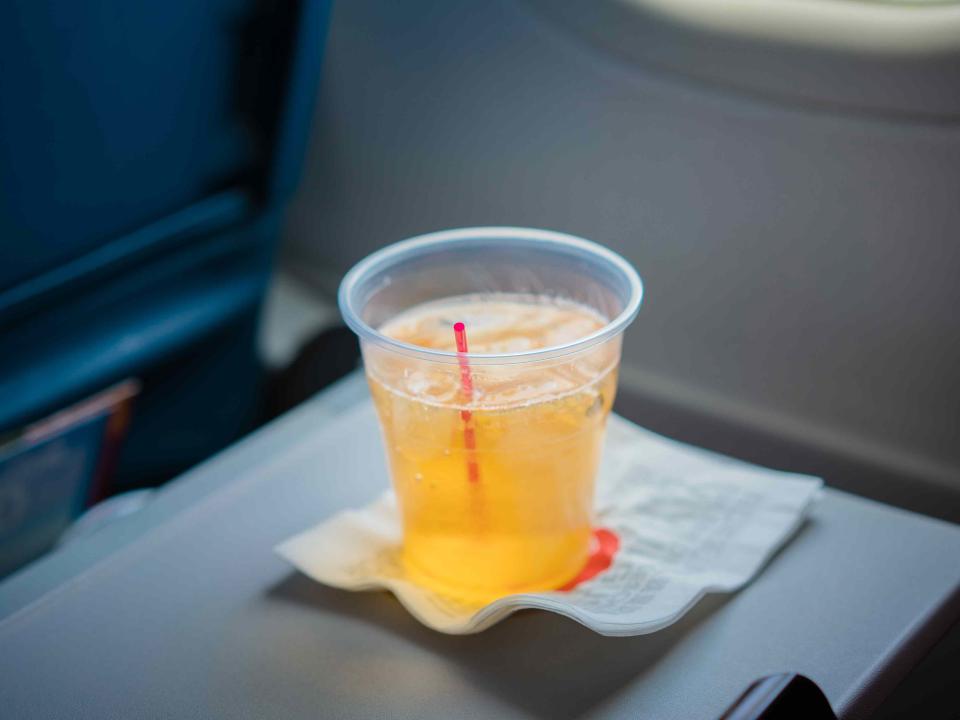Why You Should Never Order Ice on an Airplane
And more air travel food tips to know before boarding.

5m3photos/Getty Images
People love to complain about air travel. Whether it's about the long lines at security, a lengthy layover, or just the idea of getting into a metal bird-like contraption and propelling over the ocean at high speeds.
If we're being totally honest, we don't care about any of those things because that's just the beauty of air travel. There is, however, one aspect of air travel that we can all probably agree is consistently less than great: the food.
Buying food or drinks on the flight can be expensive (if they even let you purchase anything at all) and the free food isn't any better. It's almost always bland, if not downright gross, and leaves you craving food on the ground.
There are some things you can do to make your next flight's food a little bit easier to swallow.
Never Order Ice
It's a pretty well-known fact that airplanes are super germy and ordering ice might just be one of the worst things you can do when onboard.
With crews coming and going, many hands may end up in and out of the ice bins and equipment, and the crew might not necessarily have control over making sure it's fully clean and disinfected before needing to scoop ice into awaiting cups.
“The ice is put in a tray with a scoop, and the trays don’t get cleaned very often. Every surface on the plane is touched by hundreds of people daily and not often disinfected. We don’t have the opportunity to wash our hands at all during the beverage service," a Reddit user claiming to be a flight attendant commented on a viral thread.
Not only can the ice tray be dirty, but the ice itself is typically made from the plane's tap water, which is notoriously nasty. A 2019 study showed that 11 major and 12 regional airlines have unhealthy water.
Airlines only have to disinfect and flush an airplane's water tank four times per year—or once per year if they test it monthly—according to the study. While Alaska Airlines and Allegiant took the top spot for "safest water" with a 3.3 out of 5 on the "Water Health Score," the study concluded that passengers shouldn't drink "water that isn't in a sealed bottle, coffee, or tea aboard."
However, if you're someone who needs their beverage to be ice-cold, ice researchers say it's safer to do so with a strong alcoholic drink or soda. There is a "consistent reduction of bacterial risk due to alcohol, CO2, pH and antibacterial ingredients of vodka, whisky, Martini, peach tea, tonic water, and Coke," according to "Travel + Leisure."
Know Food Tastes Different on Planes
Your taste—for food and drink—is greatly impacted when you're on an airplane. The environment in a dry, pressurized cabin weakens your sense of smell, which makes up for a large part of your sense of taste. So, your sense of taste is also weakened.
Studies have shown various effects of these factors, as well as the added background noise of a plane, on our sensitivity to certain flavors. This has caused airlines to make some menu changes—like Alaska Airlines creating a specialty coffee brew with Stumptown Coffee Roasters that has an enhanced taste at 30,000 feet.
Not only does airline catering need to account for weakened taste, which they do by adding up to 30% more sugar or salt to a meal, but they're also preparing the dishes in less-than-ideal conditions. Meals are made on the ground and then frozen before the flight. Once aboard, flight attendants thaw these packages and reheat them before serving, which contributes to food tasting weird.
Pack Flavor Enhancers and Extra Snacks
So, how can you make your in-flight meal a little more appealing? You might want to consider packing flavor enhancers to doctor up your airplane food. Hot sauce packets, seasonings and spices, or condiments are all allowed—as long as they comply with security guidelines for liquids, of course. Try adding new flavors to your meals and your tastebuds will seriously thank you.
Bringing your own extra snacks is also a plus. That way if the flight attendants can't perform in-flight services due to a short flight time or turbulence, you won't go hungry. Salty snacks—like chips, nuts, and string cheese—will taste better, but if you're prone to swelling at high altitudes, some anti-inflammatory options—like fruits and veggies—are a good choice, too.
Savor the Umami
Umami is one of the five tastes responsible for savory flavors—and interestingly, it's also a taste that isn't impacted on an airplane. It's mostly found in seafood, meats, aged cheeses, soy, mushrooms, and kimchi, but it's also found in tomatoes, which is why there's always tomato juice available on a flight.
So you'll be happy to know that your Bloody Mary will still taste just as good at 30,000 feet as it does on the ground—and you won't need any ice to make it better.
Read the original article on All Recipes.

 Yahoo Lifestyle
Yahoo Lifestyle 
